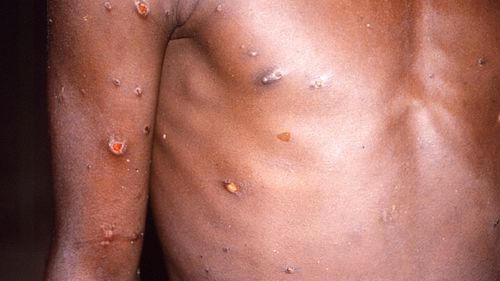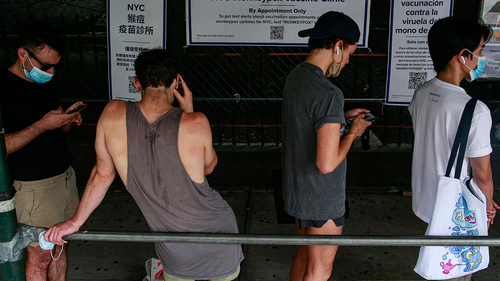“It’s a new and really fast-moving outbreak, and I think there have been some challenges around having a smooth and efficient way for the data to be sent from jurisdictions” to the US Centers for Disease Control and Prevention, said Janet Hamilton, executive director of the Council of State and Territorial Epidemiologists.

But the agency has detailed information on only about half of the reported cases, CDC Director Dr Rochelle Walensky said.
Monkeypox is now a reportable disease, which means public health departments work with local health care providers to collect information about people who are diagnosed and how they became ill. But it is still completely voluntary for states to share data on monkeypox with the CDC.
CNN reached out to the health departments of all 50 states; 29 responded, and they all said they are committed to sharing case data with the CDC. Some, however, said that they are collecting more information than they share.

As the US battles another public health challenge amid the ongoing COVID-19 pandemic, Walensky said she is “struck” by “how little authority we at CDC have to receive the data.”
“We very much want to get as much information and informed decisions out to the American public as possible. And yet again, like we were for COVID, we are again really challenged by the fact that we at the agency have no authority to receive those data. We’re working on that right now,” she said in a conversation with The Washington Post on Friday.
For example, Walensky said, the CDC has no data on who has been vaccinated for monkeypox and does not yet have the authority to collect that data.
Last month, the CDC shared an initial draft of a data use agreement with states and other jurisdictions, essentially a contract that would broaden the agency’s access to data that states are collecting.
After soliciting feedback from states, the CDC shared a revised version of the agreement that focuses exclusively on vaccine administration data. States are reviewing the document, and a few have signed it.
The latest version of the data use agreement has “similar requirements and infrastructure as the states already use for COVID-19 vaccine data reporting,” according to the CDC.
Monkeypox not yet a public health emergency in US
But so far, monkeypox has not been declared a public health emergency in the United States. US health officials said over the weekend that the United States is still assessing the situation. US Health and Human Services Secretary Xavier Becerra said in a statement Saturday the US is “determined to accelerate our response in the days ahead.”

A US declaration of a public health emergency could bring with it an official requirement to report certain data, but it’s more often used to move funds around, Hamilton said.
Although the public health emergency for COVID-19 brought reporting requirements to health care, like hospitals, the same wasn’t true for states and public health.
“Health departments have a vested interest in providing the agency data,” Hamilton said. “The public health system needs and wants to submit data.”
Even if the motivation is there, the infrastructure in place to do so can make the process challenging.
“We would love to have a regular, standardised process — even for when new diseases and conditions emerge — that at least has a way for core data to automatically be sent out of a state’s reportable disease system,” Hamilton said.
“But in the current infrastructure, that does not exist.”

Instead, it’s a “very manual process” in which, for each case, states have to either enter all of the information by hand or upload a file into the system that might miss some fields if they’re not formatted the same way.
With monkeypox, for example, evidence shows that it spreads mostly through prolonged physical contact, such as sex. People being tested for the virus may be more willing to give their clinician with a range of how many sexual partners they’ve have. But if the surveillance database requires a specific number for that question, then the categorical data collected by the clinician or health department might not be included when the case report is submitted.
Data modernisation at the CDC has been greatly underfunded, Hamilton said.
“2020, believe it or not, was the first year that the agency received appropriations for a more integrated approach to managing disease surveillance data. And, of course, that was right as the pandemic hit.”
‘We do not have enough detailed case data’
Overall, the lack of data is hindering efforts to forecast the path the monkeypox outbreak might take.
“Right now we do not have enough detailed case data to develop robust estimates,” a CDC spokesperson said.

“We anticipate that as the outbreak progresses we will be able to share forecasts,” the spokesperson said.
In the meantime, the vaccine supply is far from enough to meet demand — and covers just a fraction of the population that the CDC has recommended get it.
Cases are most likely undercounted, too.
Walensky said she anticipates an increase in cases in the coming weeks, for three main reasons: a streamlined reporting form that makes it quicker and easier for states to report cases, a surge in testing as commercial laboratories have begun to offer tests, and recent exposures that will start to show symptoms.
“It is true that we have work to do — here and internationally — and are likely to see more monkeypox cases in the near term, but it is possible to significantly decrease the number of cases and contain the current monkeypox outbreak through education and increased testing and access to vaccines — all priorities we’ve made dramatic progress on,” the CDC said in a statement to CNN.


التعليقات